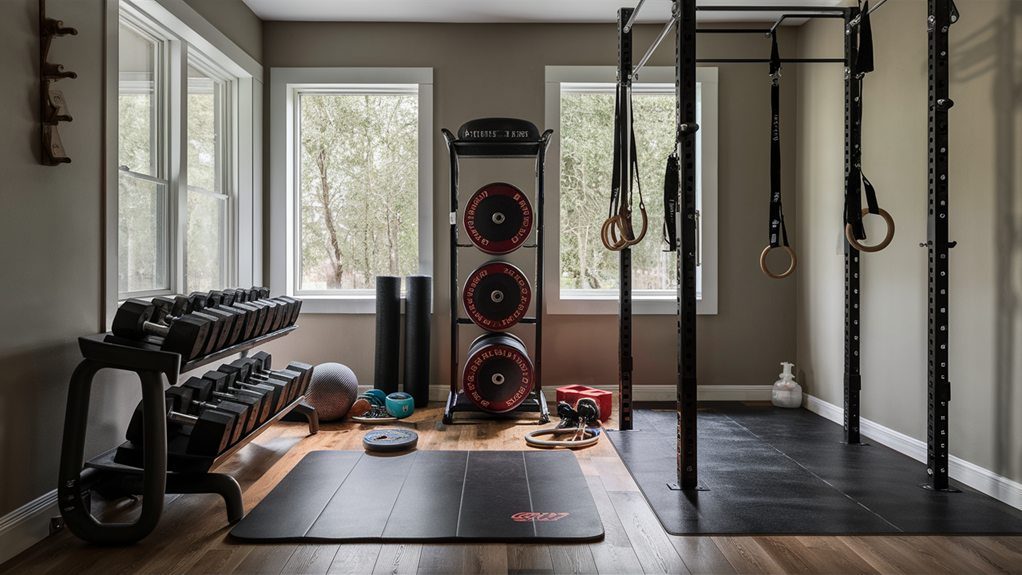Strength training is a powerful way to transform your body through resistance exercises that build muscle, increase endurance, and enhance overall fitness. You'll use equipment like weights, resistance bands, or your own body weight to perform controlled movements that target specific muscle groups. Regular training offers impressive benefits, including improved bone density, faster metabolism, better mental health, and increased functional strength for daily activities. To get started, you'll need basic gear like athletic shoes, dumbbells, and an exercise mat, while focusing on essential moves like squats, deadlifts, and bench presses. The journey to a stronger you begins with mastering proper form and technique.
What Is Strength Training

Strength training is a form of physical exercise that builds muscle power, endurance, and mass through resistance. When you're looking for an introduction to strength training, you'll discover it's all about challenging your muscles through various exercises that make them work harder than usual.
This type of training typically involves using weights, resistance bands, or even your own body weight to create the resistance needed for muscle development. Incorporating different methods like free weights and machines can enhance your training experience and effectiveness, allowing you to tailor your workouts to your specific goals, such as various strength training exercises.
As a beginner in strength training, you'll focus on controlled movements that target specific muscle groups, helping you build both strength and stability. You'll find that this form of exercise isn't just about lifting heavy weights; it's about mastering proper form and gradually increasing resistance as your body adapts.
Whether you're using dumbbells, machines, or bodyweight exercises, strength training helps improve your bone density, boost metabolism, and enhance your overall functional fitness.
For those wondering what strength training entails, it's important to know that it's a systematic approach to exercise, where you'll perform specific movements in sets and repetitions, allowing adequate rest between sessions for muscle recovery and growth.
Benefits of Regular Training
When you commit to regular strength training, you'll experience a wide range of physical and mental benefits that extend far beyond just building muscle. Not only does it enhance your overall fitness, but it also complements other forms of exercise, such as boosting cardiovascular health.
Your body will undergo remarkable changes as you develop better posture, increased bone density, and improved joint stability through consistent training sessions.
The benefits of strength training for fitness are extensive and life-changing, affecting everything from your daily activities to your long-term health. You'll notice improvements in these key areas:
- Your metabolism will speed up, helping you burn more calories even when you're resting, which leads to better weight management.
- Your body will become more resilient against injuries, thanks to stronger muscles, tendons, and ligaments that protect your joints.
- Your mental health will improve through increased endorphin production, leading to reduced stress and better sleep quality.
- Your functional strength will enhance everyday activities, from carrying groceries to playing with your kids.
Regular training also helps prevent age-related muscle loss, improves your cardiovascular health, and boosts your confidence as you become stronger and more capable in your daily life.
Essential Equipment and Gear

To get started with your strength training journey and access all these benefits, you'll need the right tools at your disposal. The essential equipment begins with proper athletic shoes that provide stability and support for your workouts, along with comfortable, moisture-wicking clothing that allows you to move freely.
Investing in quality equipment is vital for effective strength training, as it enhances your performance and reduces the risk of injury.
For resistance training, you'll want to start with a set of dumbbells in various weights, as they're versatile and perfect for beginners. A quality exercise mat will protect your body during floor exercises, while resistance bands offer a lightweight, portable option for building strength.
If you're training at home, consider investing in a sturdy weight bench, which will expand your exercise options considerably.
As you progress, you might want to add more specialized equipment like barbells, weight plates, and perhaps a power rack for safety during heavy lifts.
Don't forget smaller items that make a big difference, such as lifting gloves to protect your hands, a weight belt for supporting your back during heavy lifts, and a foam roller for post-workout recovery.
Basic Compound Movements
Basic compound movements form the foundation of any effective strength training program. These exercises work multiple muscle groups simultaneously, giving you the most benefit for your time and effort.
When you're starting your fitness journey, mastering these fundamental movements will help you build strength, improve coordination, and develop proper form. Additionally, incorporating strength training into your routine can lead to enhanced functional strength, which is essential for everyday activities and overall well-being.
The main compound exercises you'll want to focus on include:
- Squats, which target your legs, core, and back while improving overall stability
- Deadlifts, which strengthen your posterior chain, including your back, glutes, and hamstrings
- Bench Press, which develops your chest, shoulders, and triceps in one powerful movement
- Overhead Press, which builds shoulder strength and core stability while improving posture
You'll want to start with lighter weights to perfect your form before increasing the load.
As you perform these movements, focus on maintaining proper breathing patterns and keeping your core engaged throughout each exercise.
Creating Your Workout Plan

Creating an effective workout plan requires careful consideration of your goals, schedule, and current fitness level. To maximize muscle growth, it's crucial to integrate both strength training principles and proper nutrition into your routine.
You'll want to start by choosing 3-4 training days per week, spacing them out to allow proper recovery between sessions. When you're beginning, it's smart to focus on full-body workouts that incorporate the major compound movements you've learned, as these are foundational for building strength and muscle mass effective workout routines.
Start each workout with a 10-minute warm-up, including light cardio and dynamic stretches, to prepare your muscles for training. You'll want to organize your exercises by starting with the most demanding compound movements first, when you're fresh and energized.
Plan for 3-4 sets of each exercise, with 8-12 repetitions per set, allowing 1-2 minutes of rest between sets. As you progress, you can adjust these numbers based on your specific goals and response to training.
Remember to write down your workouts, including the weights you use and the number of repetitions you complete. This tracking helps you monitor your progress and guarantees you're gradually increasing the challenge of your workouts through progressive overload.
Form and Technique
Proper form serves as the foundation for every successful strength training program.
It's essential to remember that incorporating safety advice for strength training isn't just about getting better results – it's about keeping you safe and preventing injuries. You'll want to master the basics before increasing your weights or trying more complex movements.
Before starting any exercise, here are the key form elements you'll need to focus on:
- Keep your core engaged throughout the movement, which helps protect your spine and maintain stability
- Maintain controlled breathing, exhaling during exertion and inhaling during the easier phase
- Position your joints in proper alignment, avoiding any twisting or awkward angles
- Move through the full range of motion at a steady pace, never sacrificing form for speed
Remember that it's better to perform fewer repetitions with perfect form than many with poor technique.
If you're unsure about your form, work with a qualified trainer who can observe your movements and make corrections. You can also use mirrors or record yourself to check your technique and identify areas that need improvement.
Recovery and Rest Days

Rest and recovery are equally important as the workouts themselves in any strength training program. When you're lifting weights, you're actually creating tiny tears in your muscle fibers, and it's during rest periods that your body repairs and strengthens these tissues.
You'll need at least one full day of rest between training the same muscle groups to allow for proper recovery.
During your rest days, you shouldn't completely avoid activity, as light movement can actually help with recovery. You can try gentle activities like walking, stretching, or yoga to keep your body moving while giving your muscles time to heal.
It's also essential to get 7-9 hours of sleep each night, as most of your body's repair work happens while you're sleeping.
Pay attention to how your body feels, and don't ignore signs that you need more rest. If you're experiencing unusual soreness, fatigue, or decreased performance, you might need an extra recovery day.
Tracking Your Progress
Monitoring your strength gains becomes a natural next step after establishing good rest habits. You'll want to track your progress consistently, which helps you stay motivated and make smart adjustments to your training plan.
A detailed workout log can reveal patterns in your performance and highlight areas that need more attention.
There are several key metrics you'll want to record during your strength training journey:
- Weight lifted for each exercise, including the number of sets and reps you've completed
- Rest periods between sets, which can show improvements in your endurance and recovery
- Body measurements, such as chest, arms, waist, and legs, taken every 4-6 weeks
- Progress photos from consistent angles, which provide visual proof of your transformation
Recording these details doesn't need to be complicated, and you can use a simple notebook or your phone's notes app.
Don't forget to write down how you're feeling during each workout, as this information can help you identify when you're ready to increase weights or need more recovery time.
Remember to review your logs regularly, looking for trends that show your improvement over time.


